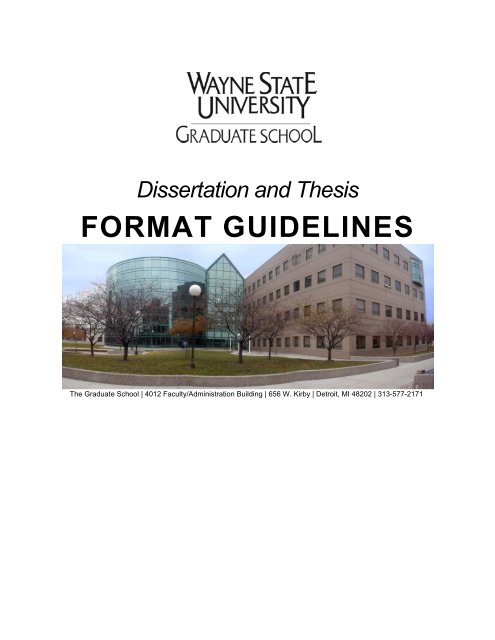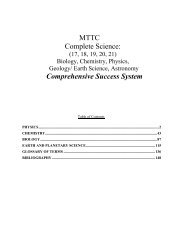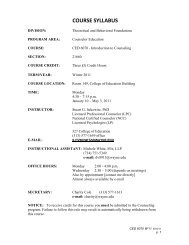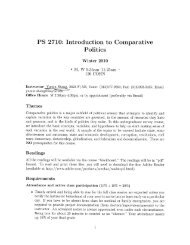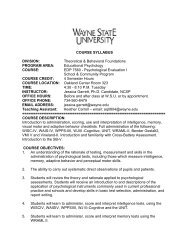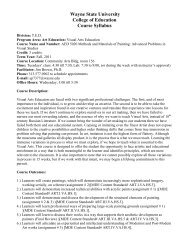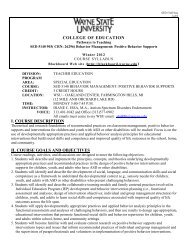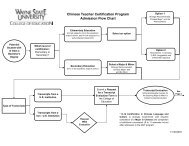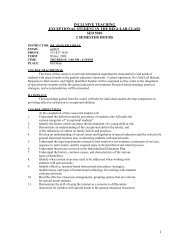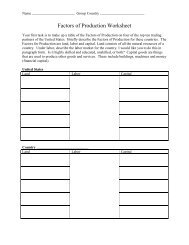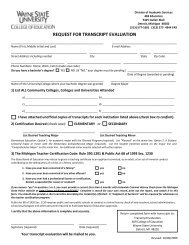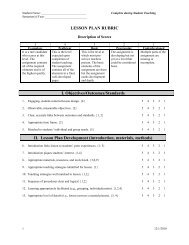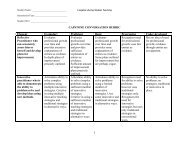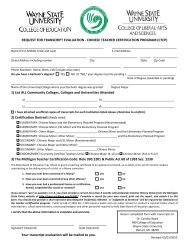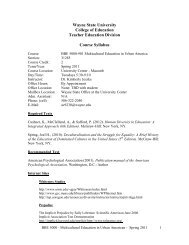Dissertation Format Guidelines - College of Education - Wayne State ...
Dissertation Format Guidelines - College of Education - Wayne State ...
Dissertation Format Guidelines - College of Education - Wayne State ...
You also want an ePaper? Increase the reach of your titles
YUMPU automatically turns print PDFs into web optimized ePapers that Google loves.
<strong>Dissertation</strong> and Thesis<br />
FORMAT GUIDELINES<br />
The Graduate School | 4012 Faculty/Administration Building | 656 W. Kirby | Detroit, MI 48202 | 313-577-2171
TABLE OF CONTENTS<br />
I. REMINDER ......................................................................................................................... 1<br />
Approval for Research Involving Human or Animal Subjects ................................................ 1<br />
II. GENERAL INFORMATION ............................................................................................... 1<br />
Graduate School Requirements ......................................................................................... 1<br />
Publication .......................................................................................................................... 2<br />
Copyright ............................................................................................................................ 2<br />
Abstract .............................................................................................................................. 2<br />
III. MANUSCRIPT FORMAT .................................................................................................. 3<br />
Margins .............................................................................................................................. 3<br />
Spacing .............................................................................................................................. 3<br />
Pagination .......................................................................................................................... 3<br />
Order <strong>of</strong> Parts ..................................................................................................................... 4<br />
Title Page ........................................................................................................................... 4<br />
Dedication, Acknowledgments, Preface or Foreword ........................................................ 4<br />
Table <strong>of</strong> Contents ............................................................................................................... 4<br />
List <strong>of</strong> Tables, Figures, or Illustrations ............................................................................... 5<br />
Inclusion <strong>of</strong> Publications in the <strong>Dissertation</strong> ....................................................................... 5<br />
IV. DEPARTMENTAL STYLE PREFERENCES .................................................................... 6<br />
V. FORMAT CHECKLIST ...................................................................................................... 8<br />
VI. HOW TO: SECTION BREAKS AND PAGINATION ......................................................... 9<br />
VII. SAMPLE PAGES .......................................................................................................... 14<br />
ii
1<br />
I. REMINDER<br />
Approval for Research Involving Human or Animal Subjects<br />
The following has been taken from the informational brochure <strong>of</strong> the Human and Animal<br />
Investigation Committee <strong>of</strong> <strong>Wayne</strong> <strong>State</strong> University.<br />
Federal regulations require that all research involving human or animal subjects must be<br />
reviewed and approved by an Institutional Review Board (IRB). For <strong>Wayne</strong> <strong>State</strong> Faculty and/or<br />
students working in University facilities and DRH-UHC, the Human Investigation Committee<br />
(HIC) and the Animal Investigation Committee (AIC) are the approved IRB’s. Because<br />
Children's Hospital <strong>of</strong> Michigan and Henry Ford Hospital have independent IRB's, faculty and/or<br />
students working in those facilities must submit research proposals to the committee at the<br />
appropriate institution for review and approval, prior to approval <strong>of</strong> the dissertation outline and<br />
prospectus.<br />
II. GENERAL INFORMATION<br />
Graduate School Requirements<br />
The Graduate School is responsible for monitoring requirements necessary for the processing<br />
<strong>of</strong> theses and dissertations. Theses and dissertations written in past years and now in the library<br />
were not necessarily prepared according to these specifications and should not be used as<br />
standards for manuscript preparation. If you have any questions, please call the Graduate<br />
School at (313) 577-2171.<br />
The style to be followed for footnotes, bibliographies, tables, chapter headings, etc. is the<br />
responsibility <strong>of</strong> the student's major department. It is the thesis/dissertation advisor's<br />
responsibility to see that the manuscripts are edited for spelling, grammar, organization, stylistic<br />
consistency, correct sequence <strong>of</strong> pages, and agreement between the table <strong>of</strong> contents and the<br />
contents <strong>of</strong> the manuscript. A list <strong>of</strong> departmental style preferences is listed on pages 6 and 7.<br />
The specifications <strong>of</strong> <strong>Wayne</strong> <strong>State</strong> University for thesis/dissertation preparation in this<br />
guidebook are primary requirements and take precedence over all styles and other guidelines<br />
for margins, spacing, pagination, order <strong>of</strong> parts, etc.
2<br />
Publication<br />
Prior to the conferral <strong>of</strong> the degree, candidates may find it desirable or expedient to publish<br />
certain findings, which later will be incorporated in the thesis or dissertation. In this case,<br />
appropriate acknowledgment <strong>of</strong> the earlier publication must be included in the manuscript.<br />
Students are required to have the dissertation/thesis published so that the manuscripts are<br />
available to the entire academic community.<br />
Copyright<br />
A candidate may initiate an application for copyright by 1) signing the relevant section <strong>of</strong> the<br />
Publishing Agreement Form, 2) paying the required fee, and 3) including a copyright notice as<br />
the first <strong>of</strong> the preliminary pages <strong>of</strong> the manuscript. This page is not numbered or included in<br />
the numbering sequence and it should be centered vertically on the page.<br />
If previously copyrighted material is included in the dissertation, the student is required to obtain<br />
written permission from the author or the publisher and attach the written permission to the<br />
Publishing Agreement Form.<br />
Abstract<br />
The abstract is a succinct account <strong>of</strong> the thesis or dissertation containing a statement <strong>of</strong> the<br />
problem, procedure or method, and conclusion. The following is an excerpt on Abstract<br />
<strong>Guidelines</strong> taken from the ProQuest website:<br />
We no longer have a word limit on your abstract…However, we continue to<br />
publish print indices that include citations and abstracts <strong>of</strong> all dissertations and<br />
theses published by ProQuest/UMI. These print indices require word limits <strong>of</strong><br />
350 words for doctoral dissertations and 150 words for master’s theses.<br />
Additionally, our print indices allow only text to be included in the abstract. In<br />
the editorial process for these print publications, we will simply truncate your<br />
abstract if it exceeds these word limits and remove any non-text content. You<br />
may wish to limit the length <strong>of</strong> your abstract if this concerns you. The abstract<br />
as you submit it will NOT be altered in your published manuscript.
3<br />
III. MANUSCRIPT FORMAT<br />
• All text should be double-spaced and justified. Long quotations and footnotes should be<br />
single-spaced (if they are 4 lines [or according to your specific format: MLA, APA, etc.] or<br />
more in length).<br />
Margins<br />
The following margins are designed to facilitate ProQuest requirements for the required<br />
publishing and optional binding: 1 to 1 ¼ for all margins (top, bottom, left and right). The bottom<br />
margin may be wider if illustrations or tables bigger than half the page cannot be placed with the<br />
text and have to be placed on a separate page, or if section headings would otherwise be left<br />
standing alone (section headings should remain with the paragraph to which they refer). The<br />
text must also be justified.<br />
Spacing<br />
All preliminary pages, the body <strong>of</strong> text, and the references should be double spaced. The text<br />
should be justified, indent to show new paragraphs. Quotations 4 lines (or according to your<br />
specific format: MLA, APA, etc) or less should be double-spaced; quotations exceeding four<br />
lines should be single-spaced. Captions/legends for tables and figures should be singlespaced.<br />
Pagination<br />
Preliminary pages: Copyright page (if included) is not numbered. The dedication,<br />
acknowledgments, preface, table <strong>of</strong> contents, and lists <strong>of</strong> tables and/or figures are numbered<br />
consecutively in lower case Roman numerals at the bottom center <strong>of</strong> each page, starting with<br />
"ii".<br />
Text: Use Arabic numbers beginning with "1" on the first page <strong>of</strong> the text and continuing<br />
throughout the manuscript, including the appendices, reference material, abstract, and<br />
autobiographical statement. The page numbers should be on the top center <strong>of</strong> the page<br />
throughout the text, and they should be within the top margin, approximately ½ inch to ¾ inch<br />
form the top edge <strong>of</strong> the paper. (The text should be no more than 1 ¼ inches from the edge <strong>of</strong><br />
the paper and the page numbers should be within the margin.)
4<br />
Order <strong>of</strong> Parts<br />
The thesis or dissertation manuscript falls into three main parts <strong>of</strong> division: the preliminary<br />
pages, the text, and the reference materials. Parts <strong>of</strong> some <strong>of</strong> these sections are optional, but<br />
the order, regardless <strong>of</strong> what parts may be left out, is as follows:<br />
• Title page<br />
• Copyright page (optional)<br />
• Dedication, Acknowledgments, Preface or Foreword (if appropriate)<br />
• Table <strong>of</strong> Contents<br />
• List <strong>of</strong> Tables (if appropriate)<br />
• List <strong>of</strong> Figures, Maps, Charts, Diagrams, and Schemes (if appropriate)<br />
• Text, including the introduction and all chapters<br />
• Appendix (if appropriate)<br />
• Bibliography or References (required)<br />
• Abstract (required)<br />
• Autobiographical <strong>State</strong>ment (required)<br />
Please view the sample pages at the end <strong>of</strong> this document.<br />
Title Page<br />
Title <strong>of</strong> the manuscript must be all in capital letters and single-spaced. The author's name, also<br />
all in capital letters, must be identical on the Title Page, Copyright Page (if applicable), and the<br />
Abstract. The area <strong>of</strong> specialization may be shown in parentheses following the major (in mixed<br />
case) where such breakdowns exist:<br />
e.g.<br />
MAJOR: PSYCHOLOGY (Clinical)<br />
Dedication, Acknowledgments, Preface or Foreword<br />
These sections are optional and, if included, should appear on separate pages in the order<br />
shown. The dedication, as the name suggests, is a personal dedication <strong>of</strong> one's work. The<br />
acknowledgments are brief notes <strong>of</strong> appreciation for assistance given to the candidate in the<br />
research and preparation <strong>of</strong> the thesis or dissertation. A preface or foreword may contain the<br />
author's statement <strong>of</strong> the purpose <strong>of</strong> the study or special notes to the reader.<br />
Table <strong>of</strong> Contents<br />
Each thesis or dissertation must have a table <strong>of</strong> contents which shows the principal divisions <strong>of</strong><br />
the work and the page numbers on which they are found. List all <strong>of</strong> the preliminary pages<br />
included except for the title, copyright, and table <strong>of</strong> contents pages. In cases where there are<br />
two or more appendices, list each appendix and its content. The table <strong>of</strong> contents must also list<br />
reference, abstract, and autobiographical statement pages and the page numbers on which they<br />
are found at the 1 - 1 ¼ inch right margin.
5<br />
List <strong>of</strong> Tables, Figures, or Illustrations<br />
When tables, figures, or charts have been placed in the body <strong>of</strong> the manuscript (not in the<br />
appendix), separate lists must be included and should follow the table <strong>of</strong> contents page in the<br />
order indicated. Each entry on the list should carry the same caption or title as is shown on the<br />
corresponding figure in the text and show the pages on which they may be found at the 1 - 1 ¼<br />
inch right margin.<br />
Inclusion <strong>of</strong> Publications in the <strong>Dissertation</strong><br />
In those instances when doctoral students have published work in discipline appropriate<br />
refereed journals and when the student's doctoral committee approves, these published<br />
materials may be incorporated into the dissertation. For papers included in the dissertation, the<br />
Ph.D. candidate must be the principal author or have made the major contribution to the<br />
published work. In cases <strong>of</strong> co-authored papers, the text <strong>of</strong> the dissertation, most likely in the<br />
summary and conclusions, must make clear to the reader the original contributions <strong>of</strong> the<br />
author. In addition, when a paper is co-authored by those in addition to the Ph.D. candidate and<br />
the advisor, we recommend that approval be given by the other authors for inclusion <strong>of</strong> the<br />
published materials.<br />
Students must reformat a published article for incorporation within the body <strong>of</strong> the dissertation.<br />
In all instances the remaining sections <strong>of</strong> the dissertation (e.g., abstract, introduction, and<br />
conclusion) should conform to the structure <strong>of</strong> the format requirements outlined earlier.<br />
Additionally, these sections should reference the published materials when appropriate but may<br />
be less detailed than those dissertations that do not incorporate published materials. Students<br />
should be advised that incorporation <strong>of</strong> material published elsewhere require copyright<br />
permission from the copyright holder.
6<br />
IV. DEPARTMENTAL STYLE PREFERENCES<br />
<strong>College</strong> <strong>of</strong> <strong>Education</strong><br />
Turabian and American Psychological Association<br />
<strong>College</strong> <strong>of</strong> Engineering<br />
Biomedical<br />
Chemical & Materials Sci.<br />
Civil & Environmental<br />
Electrical & Computer<br />
Industrial<br />
Mechanical<br />
Journal <strong>of</strong> Biomechanics<br />
No specific style preference<br />
American Society <strong>of</strong> Civil Engineers<br />
I.E.E.E. Style Manual<br />
No specific style preference<br />
American Society <strong>of</strong> Mechanical Engineers<br />
<strong>College</strong> <strong>of</strong> Fine, Performing, & Comm. Arts<br />
Art and Art History<br />
Communication<br />
Theatre<br />
No specific style preference<br />
American Psychological Association and Modern<br />
Language Association<br />
Modern Language Association<br />
<strong>College</strong> <strong>of</strong> Liberal Arts and Sciences<br />
Audiology and Speech<br />
Language Pathology American Psychological Association<br />
Anthropology<br />
American Anthropological Association<br />
Biological Sciences Journal style <strong>of</strong> specific field<br />
Chemistry Handbook for Authors, American Chemical Society, 1978<br />
Classical and Modern<br />
Languages, Literatures<br />
And Cultures<br />
Modern Language Association Handbook<br />
Computer Science Journal <strong>of</strong> the Association <strong>of</strong> Computing Machinery<br />
Economics<br />
Journal <strong>of</strong> Macroeconomics<br />
English<br />
Modern Language Association Handbook<br />
Geography & Urban<br />
Planning<br />
Turabian, with modifications; other format with Graduate<br />
Committee approval; consult dept. for graphic and<br />
cartographic design<br />
Geology<br />
Geological Society <strong>of</strong> America Bulletin<br />
History<br />
Chicago Manual <strong>of</strong> Style<br />
Humanities<br />
Modern Language Association Handbook<br />
Mathematics<br />
American Mathematical Society Manual<br />
MISP<br />
Modern Language Association Handbook<br />
Nutrition & Food Science Journal <strong>of</strong> Nutrition and Journal <strong>of</strong> Food Science<br />
Physics<br />
American Institute <strong>of</strong> Physics Manual<br />
Philosophy<br />
Turabian<br />
Political Science<br />
Turabian, with modifications<br />
Psychology<br />
American Psychological Association<br />
Sociology<br />
American Sociological Association
7<br />
School <strong>of</strong> Medicine<br />
Anatomy & Cell Biology<br />
Journal <strong>of</strong> Cell Biology; Journal <strong>of</strong> Neuroscience; or<br />
Graduate Committee approval<br />
Biochemistry & Molecular<br />
Biology<br />
Journal <strong>of</strong> Biochemistry and departmental guide<br />
Cellular & Clinical<br />
Journal <strong>of</strong> Neuroscience<br />
Neurobiology<br />
Community Medicine Turabian<br />
Immunology & Microbiology Journal <strong>of</strong> Virology, Journal <strong>of</strong> Bacteriology<br />
Medical Physics (Ph.D.) American Institute <strong>of</strong> Physics Style Manual<br />
Pathology<br />
Turabian<br />
Pharmacology<br />
Journal <strong>of</strong> Pharmacology and Experimental<br />
Therapeutics<br />
Physiology<br />
Departmental guide<br />
Psychiatry<br />
American Psychological Association<br />
Radiological Physics (M.S.) American Institute <strong>of</strong> Physics Style Manual<br />
<strong>College</strong> <strong>of</strong> Nursing<br />
American Psychological Association<br />
<strong>College</strong> <strong>of</strong> Pharmacy and Allied Health<br />
Pharmaceutical Sciences Turabian, with Journal modifications<br />
School <strong>of</strong> Social Work<br />
American Psychological Association
8<br />
V. FORMAT CHECKLIST<br />
The following is the checklist that that Administrator uses to check each <strong>Dissertation</strong> and Thesis<br />
format. This checklist is not exhaustive, but represents the majority <strong>of</strong> formatting problems that<br />
student’s overlook before submitting the manuscript for a format check. Please go through<br />
each and read thoroughly checking your manuscript as you go. Thank you!<br />
The format <strong>of</strong> your dissertation/thesis is NOT APPROVED for the following reasons:<br />
TITLE PAGE<br />
Title single‐spaced, bold and in CAPS<br />
Candidate’s name bold and in CAPS<br />
Line up “MAJOR,” “Approved by,” and “Advisor” under the first number <strong>of</strong> the year (which should be<br />
centered under the degree)<br />
Double‐spaced evenly throughout (except for title)<br />
PRELIMINARY PAGES<br />
Dedication, Acknowledgements and Preface come before the Table <strong>of</strong> Contents<br />
List <strong>of</strong> Tables and List <strong>of</strong> Figures come after the Table <strong>of</strong> Contents (tables and figures should have titles)<br />
Table <strong>of</strong> Contents should be evenly double‐spaced<br />
PAGE NUMBERING<br />
Copyright page should not be numbered<br />
Preliminary Pages: lowercase, roman numerals at bottom center within the margin (starting with “ii”)<br />
Main body <strong>of</strong> text: top center within the margin (starting with “1”)<br />
MARGINS<br />
Must be 1” to 1.25”<br />
Must be justified (straight edges on both left and right sides)<br />
First sentence <strong>of</strong> each paragraph should be indented, with no extra space between paragraphs<br />
No landscape pages – please rotate tables/figures to fit on portrait page and keep page number at top as<br />
usual.<br />
REFERENCES<br />
Must be evenly double‐spaced throughout (no additional spaces between references; hanging indentations<br />
or numbers should distinguish references)<br />
Appendices should come BEFORE references<br />
ABSTRACT<br />
Title must be exactly the same as on Title Page (single‐spaced, bold, in CAPS)<br />
Name in CAPS and identical to name on Title Page<br />
Date should be month and year <strong>of</strong> graduation (May, August or December) and mixed caps (no comma)<br />
Left Align Advisor, Major, Degree<br />
First line <strong>of</strong> paragraph should be indented<br />
Double‐spaced evenly throughout<br />
AUTOBIOGRAPHICAL STATEMENT<br />
Must include and must be only one page (any format <strong>of</strong> your choosing)<br />
SPACING<br />
Evenly double‐spaced throughout, except long quotations and footnotes, which should be single‐spaced<br />
OTHER:
9<br />
VI. HOW TO: SECTION BREAKS AND PAGINATION<br />
Section Breaks vs. Page Breaks<br />
Section breaks are used when a page in your manuscript requires different margin settings or<br />
other, unique formatting. Page breaks are used only to separate information (i.e. you can add<br />
information to Chapter 1 without the Chapter 2 heading being pushed down the page). There is<br />
only a need to use one <strong>of</strong> these at a time, not both together. Using both results in the insertion<br />
<strong>of</strong> a blank page between sections.<br />
To see if you’ve used either a section break or a page break or both, select the following button:<br />
Once you are able to see the breaks, you may delete/adjust accordingly. Generally, you should<br />
place the breaks after the last sentence in your section as opposed to at the bottom <strong>of</strong> the page.
10<br />
When your breaks are placed appropriately, you are ready to tackle pagination!<br />
First, format the page numbers to begin with “ii”<br />
Second, double click at the bottom <strong>of</strong> the page where the footer would go. When your curser is<br />
in the footer, click on:
11<br />
Third, insert page numbering:<br />
Now that your preliminary section has the roman numerals at bottom center, we can move on to<br />
the main body <strong>of</strong> the text, starting with arabic numbers (1,2,3, etc.) at top center.<br />
Above Chapter 1 heading, double click until the header information shows up. You will have to<br />
first, “unclick” “Link to Previous” so that the page numbers do not continue the same formatting<br />
throughout the entire manuscript:
12<br />
Now you are ready to repeat the same process for formatting page numbers.<br />
Next, format the page numbers for the Arabic numbers.
13<br />
Lastly, insert page numbers:<br />
PLEASE NOTE: The title page and copyright pages should not be numbered so insert section<br />
break without linking to previous to avoid adding page numbers to these pages.<br />
To center the copyright information on the page, do the following:
14<br />
VII. SAMPLE PAGES<br />
The following pages are samples <strong>of</strong> what your manuscript should look like when you follow the<br />
formatting instructions and below is a quick look at the sections and pagination appropriate for<br />
each.<br />
PAGINATION<br />
none<br />
starting with “ii”<br />
at bottom center<br />
starting with “1”<br />
at top center<br />
PART (those in bold are required)<br />
Title page<br />
Copyright page<br />
Dedication<br />
Acknowledgements<br />
Preface<br />
Table <strong>of</strong> Contents<br />
List <strong>of</strong> Tables<br />
List <strong>of</strong> Figures<br />
List <strong>of</strong> Schemes (maps, charts, diagrams, terms, etc.)<br />
Text (including introduction and all chapters)<br />
Appendix<br />
References<br />
Abstract<br />
Autobiographical <strong>State</strong>ment
THE TITLE OF YOUR MANUSCRIPT GOES HERE, IF IT IS MORE THAN ONE LINE<br />
LONG THEN IT SHOULD BE SINGLE-SPACED, MUST BE BOLD AND IN CAPS<br />
by<br />
YOUR NAME<br />
DISSERTATION<br />
Or, if Masters student:<br />
THESIS<br />
Submitted to the Graduate School<br />
<strong>of</strong> <strong>Wayne</strong> <strong>State</strong> University,<br />
Detroit, Michigan<br />
in partial fulfillment <strong>of</strong> the requirements<br />
Or,<br />
MASTER OF SCIENCE<br />
MASTER OF ARTS<br />
DOCTOR OF EDUCATION<br />
for the degree <strong>of</strong><br />
DOCTOR OF PHILOSOPHY<br />
YEAR<br />
MAJOR: SUBJECT (area, if <strong>of</strong>ficial)<br />
Advisor<br />
Date
© COPYRIGHT BY<br />
YOUR NAME<br />
YEAR<br />
All Rights Reserved
DEDICATION<br />
You may format your dedication<br />
however you like, but the heading, “Dedication” should be<br />
at the top exactly as seen on this page.<br />
Font does not have to be Arial. The Acknowledgments and Preface pages<br />
Should be formatted normally – double spaced evenly,<br />
Justified with first sentence <strong>of</strong> each paragraph indented, with title at top center<br />
(like this page).<br />
ii
ACKNOWLEDGMENTS<br />
You may format your Acknowledgments<br />
however you like, but the heading, “Acknowledgments” should be<br />
at the top exactly as seen on this page.<br />
Font does not have to be Arial. The Acknowledgments and Preface pages<br />
Should be formatted normally – double spaced evenly,<br />
Justified with first sentence <strong>of</strong> each paragraph indented, with title at top center<br />
(like this page).<br />
iii
TABLE OF CONTENTS<br />
Dedication<br />
Acknowledgments<br />
Preface<br />
List <strong>of</strong> Tables<br />
List <strong>of</strong> Figures<br />
ii<br />
iii<br />
iv<br />
vi<br />
vii<br />
Chapter 1 “Title” 1<br />
Sub-heading 4<br />
Sub-heading 6<br />
Chapter 2 “Title” 39<br />
Appendix A 93<br />
References 120<br />
Abstract 134<br />
Autobiographical <strong>State</strong>ment 137<br />
Each thesis or dissertation must have a table <strong>of</strong> contents which shows the principal divisions <strong>of</strong><br />
the work and the page numbers on which they are found. List all <strong>of</strong> the preliminary pages<br />
included except for the title, copyright, and table <strong>of</strong> contents pages. In cases where there are<br />
two or more appendices, list each appendix and its content. The table <strong>of</strong> contents must also list<br />
reference, abstract, and autobiographical statement pages and the page numbers on which they<br />
are found at the 1 - 1 ¼ inch right margin.<br />
You may put headings in bold and/or italics as you see fit. The Table <strong>of</strong> Contents must be<br />
EVENLY DOUBLE-SPACED with information reaching to both margins, as seen above.<br />
iv
LIST OF TABLES<br />
Table 1: The title <strong>of</strong> this could be extremely long and descriptive and would not leave<br />
room for the leader lines, but this way, you still have room……………………36<br />
Table 2: Second title <strong>of</strong> next table……………………………………………………………48<br />
The List <strong>of</strong> Tables and the List <strong>of</strong> Figures, Abbreviations, etc. must follow the same style<br />
as the Table <strong>of</strong> Contents (and each begins on a new page). All tables and figures must<br />
have titles listed. If titles are longer than one line, they may be single-spaced, as seen<br />
above.<br />
v
1<br />
CHAPTER 1 “TITLE” (You do not have to use quotes)<br />
Introduction (or sub-heading if appropriate)<br />
The only requirements for this section are that the text has to be justified (straight<br />
edges both right and left sides) and it must be evenly double-spaced throughout.<br />
Chapter headings may start on a new page, but text must start right after the heading<br />
(i.e. Chapter headings do not get their own page).<br />
There is also no additional space between paragraphs. Tables and Figures may<br />
be formatted however you and your Advisor see fit – information in Tables and Figures<br />
may be single-spaced, etc. However, landscape pages are not allowed in the<br />
manuscript. You may have a landscape style table or figure but it must be rotated to fit<br />
on a portrait style page.<br />
Lastly, notice that the page numbers have changed – they start at ‘1’ at top<br />
center.
2<br />
APPENDIX<br />
If you have more than one appendix, you may use “Appendix A, B, C, etc.” Just<br />
as Chapter headings do not get their own page, Appendix, References, etc. do not<br />
either. Information begins right after title. Here you may include any forms (HIC, AIC,<br />
etc.) permissions, surveys, etc. all formatted however you and your Advisor see fit.
3<br />
REFERENCES<br />
Last name, First name, Title, etc. you may format your references and/or bibliography in<br />
whichever way is appropriate as long as the information is evenly doublespaced.<br />
Some departments use numbering to differentiate between references. This is fine as<br />
well, however hanging indentations are most common. Again, there should be<br />
no additional space between references.
4<br />
ABSTRACT<br />
THE TITLE OF YOUR MANUSCRIPT GOES HERE, IF IT IS MORE THAN ONE LINE<br />
LONG THEN IT SHOULD BE SINGLE-SPACED, MUST BE BOLD AND IN CAPS<br />
by<br />
YOUR NAME<br />
Month <strong>of</strong> Graduation YEAR<br />
Advisor: Dr. Full Name<br />
Major: Major (area, if <strong>of</strong>ficial)<br />
Degree: Doctor <strong>of</strong> Philosophy<br />
Or,<br />
Master <strong>of</strong> Science<br />
Master <strong>of</strong> Arts<br />
Doctor <strong>of</strong> <strong>Education</strong><br />
Please note that there are no additional spaces between information – all is<br />
evenly double-spaced. Please also note what is bold and in caps and what is not. The<br />
month <strong>of</strong> graduation is the term in which you will be graduating (May, August or<br />
December), not the month during which you defended your dissertation. There should<br />
not be a comma between the month and the year on the Abstract (e.g. May 2009).<br />
This section must be justified and evenly double-spaced, like the body <strong>of</strong> text<br />
throughout the chapters. There is no length limit.
5<br />
AUTOBIOGRAPHICAL STATEMENT<br />
This section may be formatted however you see fit (save for the title at the top), but may<br />
only be one page. This is the last page <strong>of</strong> the dissertation.


